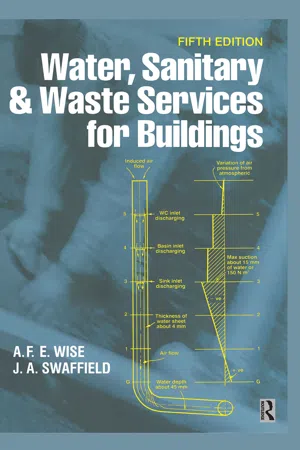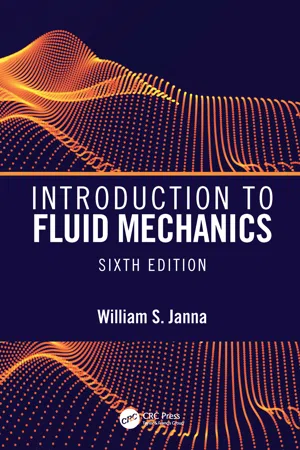Technology & Engineering
Internal Flow
Internal flow refers to the movement of fluids within enclosed systems, such as pipes, ducts, or channels. It is a key concept in fluid mechanics and is studied to understand the behavior of fluids under various conditions, including pressure, velocity, and viscosity. Internal flow analysis is important for designing and optimizing systems for efficient fluid transport and control.
Written by Perlego with AI-assistance
Related key terms
Related key terms
1 of 4
Related key terms
1 of 3
3 Key excerpts on "Internal Flow"
- eBook - ePub
- James Patrick Abulencia, Louis Theodore(Authors)
- 2011(Publication Date)
- Wiley-AIChE(Publisher)
An example of a change in flow direction is fluid flowing through a 90° elbow; alternatively, a change in flow speed occurs when the cross-section of a conduit changes. Besides changes in bulk fluid velocity, form friction losses also include changes in velocity that occur locally, i.e., internal to the bulk motion of the fluid. This occurs in turbulent flow (see Chapter 14 for more details), which is characterized by rapidly swirling masses of fluid called eddies. (1) 8.2 CONSERVATION OF ENERGY A presentation of the conservation law for energy would be incomplete without a brief review of some introductory thermodynamic principles. Thermodynamics is defined as that science that deals with the relationships among the various forms of energy. A system may possess energy due to its temperature (internal energy), velocity (kinetic energy), position (potential energy), molecular structure (chemical energy), surface (surface energy), etc. Engineering thermodynamics is founded on three basic laws. As described earlier, energy, like mass and momentum, is conserved. Application of the conservation law for energy gives rise to the first law of thermodynamics. This law for batch processes, is presented below. For batch processes (8.1) where potential, kinetic, and other energy effects have been neglected and Q is energy in the form of heat transferred across the system boundaries, W is energy in the form of work transferred across system boundaries, E (often denoted as U), the internal energy of the system, and DL E is the change in the internal energy of the system. In accordance with the recent change in convention, both Q and W are treated as positive terms if added to the system. By definition, a flow process involves material streams entering and exiting a system. Work is done on the system at the stream entrance when the fluid is pushed into the system. Work is performed by the system to push the fluid out at the stream exit - eBook - ePub
- A.F.E. Wise, John Swaffield(Authors)
- 2012(Publication Date)
- Routledge(Publisher)
8 Fluid Flow Principles and StudiesFlow conditions in building services systems, whether ventilation or entrained airflow or free surface drainage flows, obey the rules identified in the wider study of fluid mechanics. In general, the flows encountered are incompressible and may be classified as steady (no change at a point with time), unsteady (conditions varying with time), uniform (no change in conditions with change of location in the flow direction) or non-uniform (conditions change in the flow direction). In the analysis of steady flows it is normal to assume that any system may be constructed of sections where uniform flow conditions apply as this allows the application of frictional resistance formulae developed historically.In general, flow parameters are considered uniform across a flow cross-section — full bore pipe flow is assumed to move at the same velocity at all points across the section. Thus flow velocity is normally the mean velocity across the section. This is convenient but neglects the single most important point in determining frictional resistance, namely that at the pipe or channel wall the flow is stationary — the condition of no slip. A corollary to this is that two fluids in contact will share the same interface velocity, the effective rationale for entrained airflow in contact with a moving water film.The estimation of flow conditions within pipes, ducts and channels therefore depends upon these criteria and upon the relationship between the kinetic and potential energies of the fluid, any energy input to the system, for example by pump or fan action, and the changes in internal fluid energy due to frictional resistance and the disruption caused by flow through the various fittings included in the network. The flow disruption at fittings generally leads to the formation of eddies in the flow that absorb available energy and often detach the flow from the duct walls. These effects are perceived as separation pressure or head losses but are more accurately energy transfers. An overall description of these balances and a determination of the subsequent flow conditions may be determined via the Steady Flow Energy Equation developed later. Considering an ideal, frictionless and incompressible fluid, Bernoulli in 1738 derived the theorem that provides the basis for the calculation of steady flows. This states that along the streamtube* - eBook - ePub
- William S. Janna(Author)
- 2020(Publication Date)
- CRC Press(Publisher)
5 Flow in Closed ConduitsFlow in closed conduits is a very important part of the study of fluid mechanics—primarily because examples are commonplace. Water for domestic use is distributed to all parts of the household in pipes; sewers and drains carry wastewater away. Crude oil is pumped from well to refinery in pipes. Natural gas is brought to the user via pipes. Heated air is distributed to all parts of a house in circular and rectangular ducts. Many other examples of conduit flow can be found in everyday life. In this chapter, we will examine the variables that are important in mathematically describing such flows.After completing this chapter, you should be able to:- Describe velocity profiles in laminar and in turbulent flows;
- Determine the effect of viscosity for flow in a pipeline;
- Write the equation of motion for pipe flow;
- Analyze various piping systems;
- Recognize different types of pumps.
5.1 Laminar and Turbulent Flows
Experiments with flow in pipes demonstrated that two different flow regimes exist—laminar and turbulent . When laminar flow exists in a system, the fluid flows in smooth layers called laminae . A fluid particle in one layer stays in that layer. The layers of fluid slide by one another without apparent eddies or swirls. Turbulent flow, on the other hand, exists at much higher flow rates in the system. In this case, eddies and vortices mix the fluid by moving particles tortuously about the cross section.The existence of two types of flow is easily visualized by examining results of experiments performed by Osborne Reynolds. His apparatus is shown schematically in Figure 5.1 a. A transparent tube is attached to a constant-head tank with water as the liquid medium. The opposite end of the tube has a valve to control the flow rate. Dyed water is injected into the water at the tube inlet, and the resulting flow pattern is observed. For low rates of flow, something similar to Figure 5.1 b results. The dye pattern is regular and forms a single line like a thread. There is no lateral mixing in any part of the tube, and the flow follows parallel streamlines. This type of flow is called laminar , or viscous , flow
Index pages curate the most relevant extracts from our library of academic textbooks. They’ve been created using an in-house natural language model (NLM), each adding context and meaning to key research topics.
Explore more topic indexes
Explore more topic indexes
1 of 6
Explore more topic indexes
1 of 4


